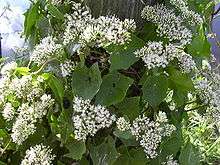Mikania
| Mikania | |
|---|---|
 | |
| Mikania scandens | |
| Scientific classification | |
| Kingdom: | Plantae |
| (unranked): | Angiosperms |
| (unranked): | Eudicots |
| (unranked): | Asterids |
| Order: | Asterales |
| Family: | Asteraceae |
| Tribe: | Eupatorieae |
| Genus: | Mikania Willd. 1803, conserved name not F.W.Schmidt 1795 (Asteraceae) nor Neck. 1790 (Moraceae) |
| Synonyms[1] | |
| |
Mikania is a genus of about 450[2] species in the boneset tribe within the sunflower family.
The name honors the Czech botanist Johann Christian Mikan, 1743–1814.[2] Members of the genus are stem twiners and lianas and are common in the neotropical flora. Mikania originates from South America. A few species, such as Mikania scandens, are found in temperate areas of North and South America, and nine species are known from the Old World tropics.[2] As with other plants in the tribe Eupatorieae, the flowers have disc florets and no ray florets.
The species Mikania laevigata and Mikania glomerata, also known as guaco, are popular in herbal medicine.
Mikania micrantha is a widespread weed in the tropics. It grows very quickly (as fast as 80 mm in 24 hours for a young plant) and covers other plants.[3] People have looked into controlling it with herbicides, parasitic plants, fungi and insects.
Selected species
- Mikania andrei (Ecuador)
- Mikania batatifolia (Florida and West Indies)[4]
- Mikania capensis (Africa)
- Mikania chimborazensis (Ecuador)
- Mikania cordifolia (northern Argentina to southeastern United States (Texas to Florida))[5]
- Mikania cuencana (Ecuador)
- Mikania harlingii (Ecuador)
- Mikania iodotricha (Ecuador)
- Mikania iserniana (Ecuador)
- Mikania jamesonii (Ecuador)
- Mikania micrantha (widespread weed in many tropical areas including southern Florida)
- Mikania millei (Ecuador)
- Mikania natalensis (Africa)
- Mikania oreophila (Brazil)
- Mikania pulverulenta (Ecuador)
- Mikania seemannii (Ecuador)
- Mikania scandens (Mexico, Bahamas, and eastern United States as far north as Maine + Michigan)[6]
- Mikania stereolepis (Ecuador)
- Mikania tafallana (Ecuador)
References
| Wikimedia Commons has media related to Mikania. |
- ↑ Flann, C (ed) 2009+ Global Compositae Checklist
- 1 2 3 "Mikania". Flora of North America.
- ↑ "INVASIVES: Newsletter of the Asia-Pacific Forest Invasive Species Network (APFISN)" (PDF). 8. February 2007.
- ↑ "Mikania batatifolia de Candolle". Flora of North America.
- ↑ "Mikania cordifolia (Linnaeus f.) Willdenow". Flora of North America.
- ↑ "Mikania scandens (Linnaeus) Willdenow". Flora of North America.
| Wikisource has the text of the 1920 Encyclopedia Americana article Mikania. |
